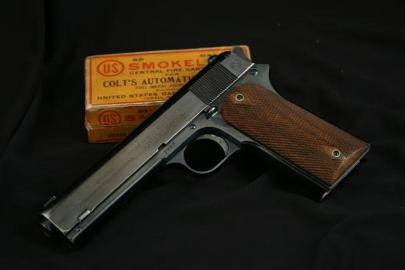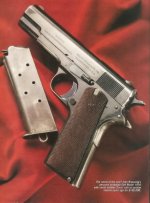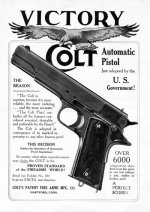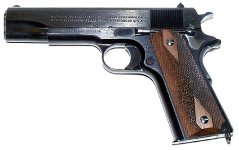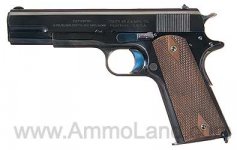Les paso un poco más de información de las pruebas realizadas por el Ejercito de los Estados Unidos de Norteamerica en 1910, entre las pistolas Colt y Savage, ambas en calibre 45 ACP:
On November 10, 1910, the Ordnance Office directed the Commanding Officer of Springfield Armory to convene a board of officers”…to make tests of such automatic pistols, caliber .45, as may be presented to them for that purpose…”. The board met on November 10, 1910.
“The President of the Board (Major Kenneth Morton) announced that two pistols had been submitted for test, and presented them to the board. The two pistols…were found to be semi-automatic, cal. .45, latest model, one manufactured by Colt’s, and the other manufactured by the Savage Arms Co. …”
This trial was of major importance. The pistols submitted were the most advanced specimens thus far developed by either manufacturer. In the case of Colt’s, the weapon was the Special Army Model 1910; the Savage pistol was a specially improved version of their Model H. Colt’s was represented by its President, Col. W.C. Skinner; two Vice Presidents, Mr. P.C. Nichols and Col. C.L.F. Robinson; plant superintendent James J. Peard; John Browning, two engineers and a mechanic were also present. Savage was similarily represented, it’s President, Vice-President, and plant superintendent were on hand; Elbert Searle, inventor of the Savage pistol, and two mechanics were present.
The tests commenced with a detailed examination of the pistols; special attention was paid to the safety devices. Field strip and complete disassembly was performed and timed. The Colt was more readily dismounted for field stripping. On the other hand, the Savage could be completely disassembled in less time than the Colt. The Colt was listed as having 64 separate components, includind the magazine; the Savage had 45 components. In the next examination, the velocity at 25 feet was obtained: 858.4 f/s for the Colt, 846 f/s for the Savage. In the accuracy trial, the Colt proved better than the Savage by shooting an average group of 1.94″ compared to 2.84″ for the Savage. The penetration tests were puzzling; the Colt did better on pine boards whereas the Savage did better on solid oak blocks. In the combined accuracy-rapidity tests the Colt was faster and more accurate than the Savage. An exhaustive endurance trial was now performed. 6000 rounds were to be fired from each weapon. The firing was to be done in cycles of 100 rounds, at which time water would be poured through the barrel. After every 1000 rounds the pistol could be cleaned and oiled.
In the first thousand, the Colt had 5 malfunctions, three of which were due to lack of adequate oiling. The Savage had 4 malfunctions; its sear had broken off and the right grip piece split and came off.
In the second thousand, the Colt had 4 malfunctions; toward the end of that run, the barrel split and had to be replaced. The Savage had 22 malfunctions; it’s extractor broke and was replaced.
In the third thousand, the Colt had 2 malfunctions; the mechanical safety broke, but this did not disable the pistol. The Savage had 7 malfunctions; grip pieces split and the bolt stop broke.
In the fourth thousand, the Colt had no malfunctions, but the slide lock failed to act properly and the grip piece screws came loose on several occasions, several jams were caused by incorrect feeding, the extractor broke, and the magazine floor plate broke. Upon examination after firing, the Savage was found to have a broken barrel lug and bolt lock spring. A new barrel and spring were installed.
In the fifth thousand, the Colt had one malfunction. The Savage had five malfunctions and a broken sear lock.
In the sixth thousand, the Colt had no malfunctions but the grip piece screws continued to work loose. The Savage had 5 malfunctions resulting from a faulty magazine.
It is interesting to note the performance of a .45 caliber Colt Revolver Model 1909, fired throughout the tests as a control. The revolver had 2 malfunctions during 6000 rounds; the first was due to the absence of powder in a cartridge, the second was due to a sticking latch.
A summary of broken parts in both automatic pistols revealed that the Colt automatic pistol required 4 replacements; the Savage 13.
On March 15, 1911 the trials were reconvened after both companies had made improvements to their weapons.
“The endurance test was now begun. 6000 rounds were to be fired in a series of 100. Between series , the pistols were allowed to cool for five minutes. The pistols were to be examined, cleaned, and oiled after every 1000 rounds.
In the 1st thousand rounds, both pistols worked perfectly, without malfunctions. In the 2nd thousand rounds, the Colt functioned perfectly. The Savage had 4 malfunctions. In the 3rd thousand rounds, the Colt functioned perfectly. The Savage suffered a broken bolt stop which was replaced. In the 4th thousand rounds the Colt functioned perfectly. The Savage had 4 malfunctions; the bolt stop and sear were found to be upset from constant pounding, the firing pin spring was found to be shortened. In the 5th thousand rounds the Colt functioned perfectly. The Savage developed a magazine release defect, and dropped its magazine five times; there was further upsetting in the bolt stop and the bolt was found to contain cracks. In the 6th thousand rounds, the Colt functioned perfectly. The Savage had 31 malfunctions; a new extractor was required, the breech plug had cracked, and thefiring pin had acquired a permanent set., the safety slide broke and the retractor spring had acquired a permament set. At the end of the firing, a careful examination of the Colt failed to reveal any defective parts.
A series of tests were performed with under-loaded and extra-loaded cartridges. Cartridges with thinned primers were also fired, and velocity was taken once more. The Board listed the following findings, conclusions, and recommendations:
“…Of the two pistols, the Board is of the opinion that the Colt’s is superior, because it is the more reliable, the more enduring, the more easily disassembled when there are broken parts to be replaced, and the more accurate…”
“…The Board therefore recommendsthat the Colt Caliber .45 Automatic Pistol of the design submitted to the Board for test be adopted for use by foot and mounted troops in the Military service in consequence of its marked superiority to the present service revolvers and to any other known pistol, of its extreme reliability and endurance and of its fulfillment of all essential military requirements…”
This report was rendered on March 20th. On March 23rd, the Commanding Officer of Springfield Armory concurred. Concurrence of the Chief of Ordnance and the General Staff followed. On March 29th, 1911 the Secretary of War approved the change.
Bady, Donald. Colt Automatic Pistols 1896-1955.





